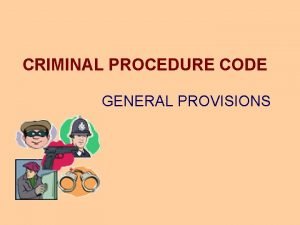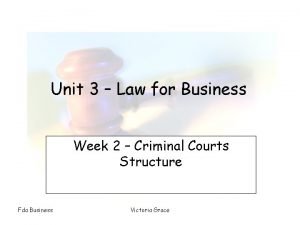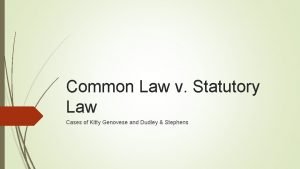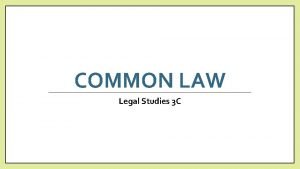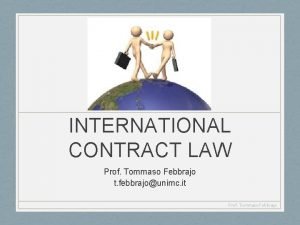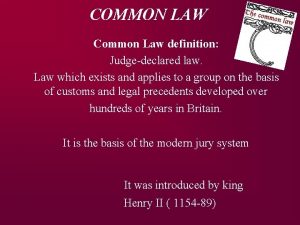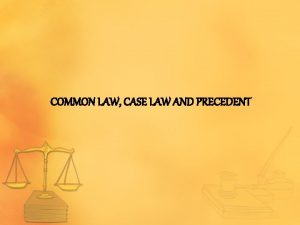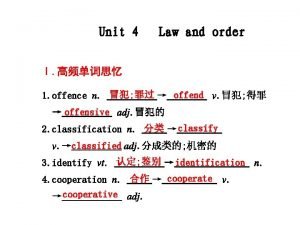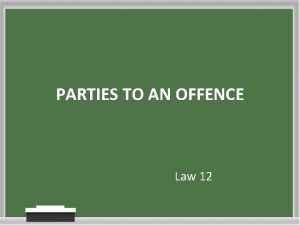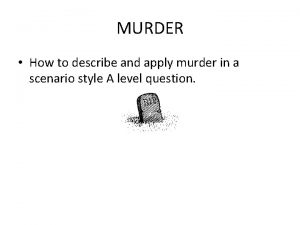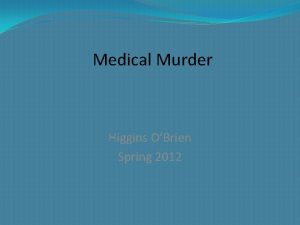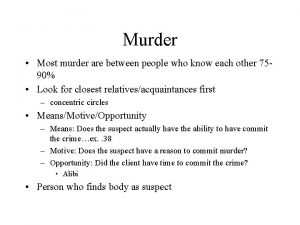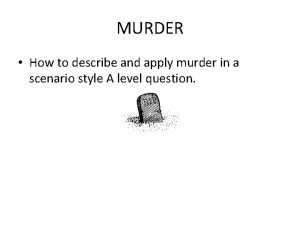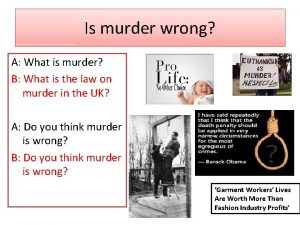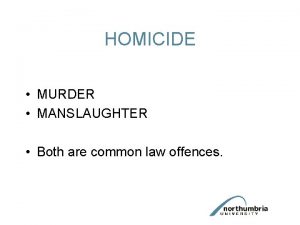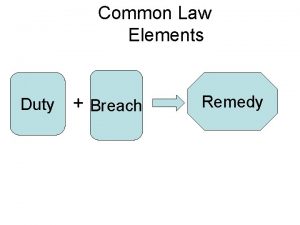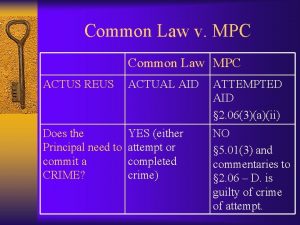Murder Revision What is murder Common law offence


























- Slides: 26

Murder Revision

What is murder? Common law offence Compulsory life sentence Result crime Mens rea and Actus reus have to coincide Must be proved by prosecutor beyond all reasonable doubt Woolmington 1935 Introduction

Definition Derives from Lord Coke in the 16 th century Whosoever shall unlawfully kill a reasonable creature in being under the queens peace with malice aforethought express or implied Introduction

Actus Reus Killing Reasonable Creature in Being Under the Queens peace Unlawfully Actus Reus

Killing • • Murder = result crime Result crimes require causation No cause = attempted murder Murder needs two types of causation – Factual – Legal • Can also be omissions Actus Reus-Killing(1)

Killing-Factual Causation • But, for tests established in the case of white (1910) • Prosecutor must prove – V would not have died ‘as’ they did, ‘when’ they did “but, for” D’s actions Actus Reus-Killing(2)

Killing-Legal Causation • • Looks at D’s responsibility &Culpability 3 rules 1. Consequence resulted from a culpable act • Dalloway (1847) 2. Act is more than minimal cause • Benge (1985) 3. No intervening acts a) Act of 3 rd party breaks chain unless its foreseeable – Pagett (1983) b) Act of victim, only when actions are unreasonable – Roberts (1871) – Williams (1992) c) Medical intervention a) Smith (1959) b) Jordan (1956) c) Cheshire (1991) Actus Reus-Killing(3)

Reasonable Creature in Being • Murder only when D kills a Independently living Human being Re. A (2000) • 3 types of victims a) Newborns/ Foetus b) Coma Victims c) Brain dead victims • Every other form of murder is just that Actus Reus-RCIB(1)

Reasonable Creature in Being 1. Newborns & Foetus 1. A/G Reference • where a foetus is attached while in the whom and born alive but died at a later date the D will be charged with murder as the baby is a reasonable creature in being at death 2. Baby must be delivered alive • Enoch (1832) 3. Must be fully expelled from the mother • Poulton (1832) 4. Umbilical cord must be cut – Moot point • Child needs not to have taken first breath – Brian Actus Reus-RCIB(2)

Reasonable Creature in Being 2. Long term comas – Old law • • D could not be held liable if v died after a year and a day Criminal Law Revision Committee – “it would be wrong for a person to remain almost indefinitely at risk for prosecution of murder, a line must be drawn somewhere” Actus Reus-RCIB(3)

Reasonable Creature in Being 3. Brian dead victim Point of death is when V is mentally unresponsive – – Brain dead is when the Brain stem test fails • • Bland (1993) Malcherek (1981) Actus Reus-RCIB(4)

Under the Queens peace • Killing enemies of the state during the time of war is not murder • R v Page (1953) • Killing prisoners of war is Murder • Killing non enemies of the state, I. E civilians, during conflict is also murder Actus Reus-UQP

Unlawfully 1. Lawful Killing – Killing does not need to be unlawful • • • War – its legal to kill an alien of the state in war Judicial executions- Nations where death penalty exists Self defence/ defence of another/ prevention of a crime – force cant be excessive 1. 2. Was the mistaken belief genuine & honest? Was the force reasonable under the circumstance? » S 76 (2) Immigration and Justice Act 2008 Actus Reus- Unlawful (1)

Unlawfully 2. Unlawful Killings – Acts and omissions • Cases apply to murder – Gibbons and Procter Actus Reus- Unlawful (2)

Unlawfully 3. Authorities – Soldiers and police may kill in line of duty unless done so ultra vires • R v Clegg – Doctors may kill in limited circumstances • • • Bodkin (1957) Bland (1993) Re A (2000) Actus Reus- Unlawful (3)

Mens Rea • Malice aforethought express or implied • Can be direct/ indirect intention • Four separate types 1. 2. 3. 4. Direct express Direct implied Indirect Express Indirect implied 1. 2. Was the consequence virtually certain? Did D personally foresee the consequence as being virtually certain? • Found in statute Mohan (1976) & common law • Test established in Woolin 1998 also applies Mens Rea Introduction

Direct intention • D’s primary aim was to kill or cause harm to the victim • Direct intention is two separate things in murder 1. Direct express- sole intention is to kill 2. Direct implied- intention to cause gbh with a consequence virtually certain to be death Woolin. But would only be found to have it if P prove to the jury that intention is that of S. 18 OAPA 1861 Mens Rea

Indirect intention • Where D embraces a course of action where the consequence is virtually certain Woolin 1998 • Indirect intent for murder is split in two 1. Indirect express- knows death is virtually certain yet continues his action 2. Indirect implied-intention to cause GBH even if the primary aim was not to cause death he should have foresaw harm Cunningham 1981 Mens Rea

Problems and Reforms to murder

Background • Law Commission report “Murder, manslaughter and Infanticide” heavily criticised current law: – Rickety structure based on shaky foundations – Some elements are outdated – Some elements have changed too much causing uncertainty Problems and Reforms to murder

Problem 1 The piecemeal approach Problems • law developed bit by bit • defined by numerous cases • meaning of ‘intention’, affects all specific intent offences • S 8 of the Criminal Justice Act 1967 a) b) jury not bound to infer intention from D’s actions was natural and probable jury to decide whether D did intend or foresee it based on the evidence • To make law coherent it needs codification Alternate view • Criticism of piecemeal is critising common law • 1967 legislation shows a) Law is not settled b) Codification is no cure • Piecemeal allows social change • If the piecemeal approach for murder is criticised then it is a problem with the law as a whole Problems & reforms- Problem 1

Problem 2 Serious harm rule problem Alternative view • D can be charged with murder without the intention to kill • 2 d’s with separate moral culpability treated equally • SHR not in Homicide Act 1957 • Vickers est SHR which Cunningham confirmed • Public policy to prove intention to kill would lower conviction rate • Burden and standard of proof • Proving ‘foresight of death’ could be problematic • Indirect intent catches dishonest murderers Problems & reforms- Problem 2

Problem 3 Excessive force problems Alternate view • Reasonable force = acquittal • Excessive force = conviction • Personality disorders not taken into account but gender and physicality is • Balance needed to prevent vigilante law • Parliament legislated self defence as a defence – Criminal justice and immigration Act S. 76 applies doctrine of reasonable force – Coroners and Justice Act allows self defence for loss of control Problems & reforms- Problem 3

Problem 4 Duress Problems & reforms- Problem 4

Problem 5 Life sentence problems Alternate view • Life should not have a minimum term imprisonment • CJA 2003 • Life = life- murders who are released can go back whenever • Murder is murder and should be distinct – Life = Serial killers, Sex & sadistic child killers, political assassins – 30 years- sex/sadistic killers, radicals, shootings, cop killers – 15 years- everyone else Problems & reforms- Problem 5

Proposed Reforms Problems & reforms- Proposed reforms
 Revision passive voice
Revision passive voice The supreme court
The supreme court Stages of money laundering process
Stages of money laundering process Predicate offence for money laundering
Predicate offence for money laundering Cognizable offence
Cognizable offence Indictable offence
Indictable offence Indictable offence
Indictable offence Indictable offence
Indictable offence Manners meaning
Manners meaning Indictable offence
Indictable offence What's a summary offence
What's a summary offence Strict liability
Strict liability Strict liability crime
Strict liability crime What are statute laws
What are statute laws Precedent example
Precedent example Common law and civil law
Common law and civil law Common law and civil law
Common law and civil law International contracts
International contracts Newton's first law and second law and third law
Newton's first law and second law and third law Newton's first law of motion
Newton's first law of motion Boyle's law charles law avogadro's law
Boyle's law charles law avogadro's law P=k/v
P=k/v Find the common multiples of 12 and 18
Find the common multiples of 12 and 18 Common anode and common cathode
Common anode and common cathode Factor tree for 72
Factor tree for 72 Factors of 54
Factors of 54 Lcm of 48 and 60
Lcm of 48 and 60




